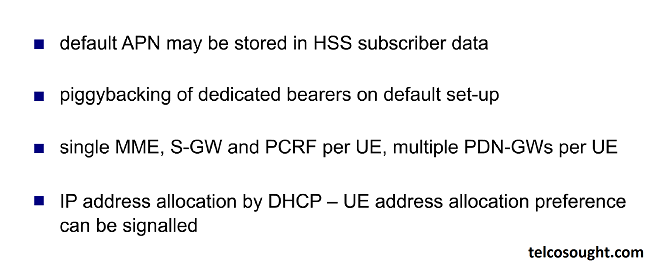In the LTE 4g article, we learn about EPS Service Concepts & Device Selection. In the Attach process as part of the Attach process, the EPS will determine at a minimum a default bearer to the UE.
Also Read These topic:-
EPS Service Concepts.
In the Attach process as part of the Attach process, the EPS will determine at a minimum a default bearer to the UE. The details of a default APN’ that will be used for the bearer can be found in the HSS profile of the subscriber or could be chosen automatically via the EPC.
HSS data could also reveal whether dedicated bearers are required to be created in addition to the default bearer at the time of the attachment.
Every UE regardless how many EPS bearers it’s created as well as the PDN Connectivity Services it is employing, can only be serviced through only one MME or S-GW a moment (except for the short but inevitable overlap when a move is made). Connection determinations regarding the establishment of a rating on behalf of every UE will be performed through the PCRF within networks that use dynamic PCC. This ensures that decisions related to service are made through a single device that has all information about the current service set for the UE in its possession.
The allocation of IP addresses is an element of Default Bearer creation process. all connected Dedicated Bearers will share the identical IP address.
The UE is usually allocated an IP within the allocated range by the default APN It is an option for UE to indicate that it needs an IP address which is given by the other PDN with which an APN connects. In both instances, the default allocating method will be DHCP (Dynamic Host Configuration Protocol) however an allocation of IP addresses that is static (based on an address recorded in the HSS information) is also allowed.
EPS Device Selection
Each bearer in the EPS system will be moved through a certain number of gadgets. In the case of an EPS Bearer that is established between the UE’s E-UTRAN home and the home EPC the set of devices would be an eNB, MME, an S-GW, and a PDN-GW. Since each network is anticipated to have a variety of different types of devices connected on it, method of the devices that are involved serve a bearer be specified clearly. The selection of devices for EPS connections works in the following manner:
The UE selects the eNB it will make use of based on the air interface selection and reselection.
The eNB chooses the MME to choose in the MME Pool available based on the principles of load balancing and any present overload notifications. Load balancing is handled using the MME “weighting factor,” that is linked to the capacity of the MME and is communicated to eNBs by using an MME Relative Capacity information in the MME Configuration message that is sent during S1 configuration. An MME that has a capacity of zero cannot accept connections. an MME that has the capacity of 255 is the greatest capacity.
The eNB doesn’t select the MME when it comes to MME Relocation, if the target MME is chosen by the MME that is the source MME. The SGSN is the one responsible in MME selection in cases of handovers between RATs.
The MME chooses the S-GW to select from the set that is associated with the current UE Tracking Area, and also takes any recent overload notifications into consideration. The MME could also take the current UE TA List into consideration when selecting an S-GW that is serving one or more TAs in the list.
The PDN-GW is chosen by the MME in a manner based on APN details that are stored in the HSS subscription information or the USIM.
It is standard among network service providers to provide service reliability by deploying several versions of an APN to various PDN-GWs. it ensures that even if one PDN-GW fails , the APN service will continue to function.

